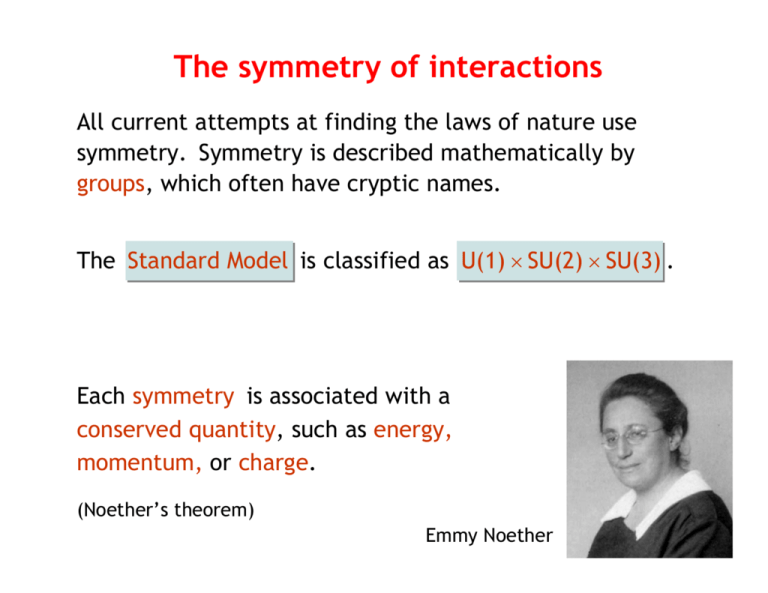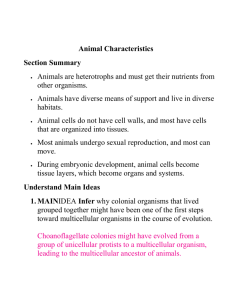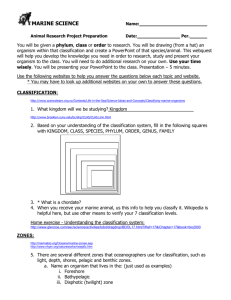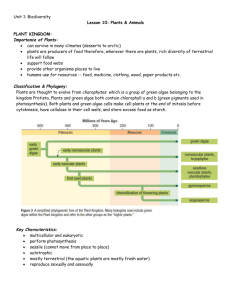The symmetry of interactions
advertisement

The symmetry of interactions All current attempts at finding the laws of nature use symmetry. Symmetry is described mathematically by groups, which often have cryptic names. The Standard Model is classified as U(1) SU(2) SU(3) . Each symmetry is associated with a conserved quantity, such as energy, momentum, or charge. (Noether’s theorem) Emmy Noether What is U(1) ? U(1) is the symmetry group of the electromagnetic interaction. “1” Fermions act as singles. 1 fermion: (electron) 1 boson: (photon) What is SU(2) ? SU(2) is the symmetry group of the weak interaction. “2” 2 fermions: 3 bosons: Fermions act as pairs. neutrino electron (Z,W+,W-) SU(3) for color SU(3) is the symmetry group of the strong interaction. “3” 3 fermions: 8 bosons: Fermions act as triplets. red quark green quark blue quark Each gluon connects two quarks with (8 gluons) 3 colors each: 3x3 = 9 combinations “White” is excluded: 8 gluons SU(5) for unification Unification attempts to treat all interactions as one , with the same coupling constant and the same symmetry group. The most popular symmetry group for unification is SU(5). A grand unified theories (GUT) unifies all three interactions of the Standard Model at high energies, where the coupling constants approach each other (next slide). Gravity is still left out, because of it is so weak. Our best bet for incorporating gravity is string theory (Lect. 39). Symmetries Symmetry of a quantum field SU(2), SU(3) “gauge symmetry” Symmetries of space-time Translation in space: x x+a Time-reversal: t −t Supersymmetry a is continuous ± is discrete boson fermion Symmetry of a quantum field “Gauge symmetry” • All current quantum field theories are gauge-symmetric. • Each interaction has its own symmetry group: U(1) = Electromagnetic SU(2) = Weak SU(3) = Strong • The conserved quantity of a gauge symmetry is the charge (electric charge, isospin, color). Symmetries of space-time • Continuous symmetries Translations, rotations in space-time (Lect. 6, Slide 13) Momentum, energy, angular momentum are conserved. • Discrete symmetries C = Charge reversal P = Inversion (parity) T = Time reversal particle antiparticle x,y,z −x,−y,−z t −t • Supersymmetry Extra space-time coordinates with a·b=−b·a boson fermion Supersymmetry The last untapped space-time symmetry • Each fermion is teamed up with a boson as super-partner and vice versa. • Since none of the known particles are super-partners of each other, one expects new particles with high mass. • Super-partners could appear at the LHC, particularly the neutralinos, fermion partners of the photon, Z, and Higgs. • The lightest neutralino is a top candidate for a WIMP, a heavy particle explaining dark matter (Lect. 18, Slide 2). Convergence of coupling constants with supersymmetry Electromagnetic Coupling constants are not constant. They change with energy and approximately converge onto a single, unified coupling constant. Weak Supersymmetry predicts a new set of supersymmetric particles above 1 TeV. They change the energy dependence of the coupling constants (solid vs. dashed). Now the convergence is improved, and the unified coupling constant is close to the simple number 1/8 . Strong 1 Energy (GeV) TeV Planck Energy Caution! This is an extrapolation over 13 orders of magnitude in energy. Symmetry breaking • Although we have all these nice symmetries, they are often only approximate. One says that the symmetry is broken. • It appears that nature always tries to get away with breaking the symmetry as much as possible without violating the most basic principles of physics (relativity, causality). Discrete symmetry breaking The weak interaction breaks the symmetries C, P, T. • Charge reversal symmetry C requires equal amounts of matter and anti-matter, but our universe consists mostly of matter. • Inversion symmetry P is broken by a different treatment of left- and right-handed particles. The Standard Model contains only left-handed neutrinos. • The CPT theorem states that the combination of C, P, T should be preserved for very general reasons (relativity). This has been verified at the level of 90 parts per trillion by comparing the e/m ratios of a proton and antiproton. Minimal symmetry breaking • The Higgs field breaks the SU(2) symmetry of the weak interaction in order to create mass. • The symmetry is broken in a rather subtle way: The laws of physics are symmetric but our universe is not. • Example: Maxwell’s equations do not favor any direction. This rotational symmetry is broken by a magnet, such as a compass needle, which points in a particular direction. • Many benefits of symmetry are preserved, because the laws of physics remain symmetric. Symmetry breaking by the Higgs field The Higgs field does not choose a particular direction, like a magnet. It chooses a particular average value. All other fields oscillate around zero. Higgs field All other fields 0 The non-zero average of the Higgs field produces the “molasses” effect that creates the mass of particles. 0 The anthropic principle The concept of minimal symmetry breaking can be pushed into the realm of philosophy. Suppose that many universes exist which all obey the same laws of physics. Each of them breaks the symmetry in a different way and thereby creates different particle masses and coupling constants. Some argue that our universe must have coupling constants that allow humans to exist and ponder the laws of nature. For example, the Sun can’t be too hot or too cold for life. This is a slick excuse for our inability to predict the many parameters of the Standard Model (about 20). The most important of them is the electromagnetic coupling constant . For values of slightly smaller or larger than 1/137 the Sun would be too hot or too cold for life (see Lect. 31, Slide 3).







